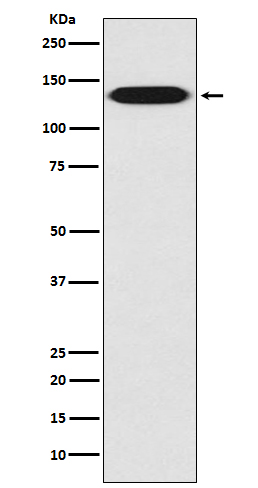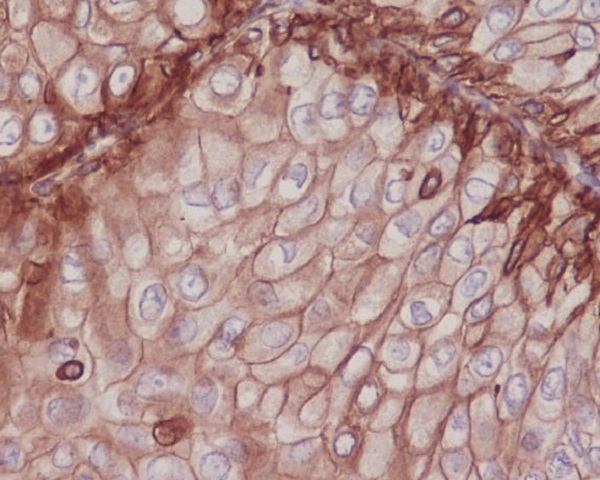

| WB | 1/500-1/1000 | Human,Mouse,Rat |
| IF | 咨询技术 | Human,Mouse,Rat |
| IHC | 1/50-1/100 | Human,Mouse,Rat |
| ICC | 技术咨询 | Human,Mouse,Rat |
| FCM | 咨询技术 | Human,Mouse,Rat |
| Elisa | 咨询技术 | Human,Mouse,Rat |
| Aliases | ITGB1; FNRB; MDF2; MSK12; Integrin beta-1; Fibronectin receptor subunit beta; VLA-4 subunit beta; CD antigen CD29 |
| Entrez GeneID | 3688 |
| WB Predicted band size | Calculated MW: 88 kDa; Observed MW: 140 kDa |
| Host/Isotype | Rabbit IgG |
| Antibody Type | Primary antibody |
| Storage | Store at 4°C short term. Aliquot and store at -20°C long term. Avoid freeze/thaw cycles. |
| Species Reactivity | Human,Mouse,Rat |
| Immunogen | A synthesized peptide derived from human Integrin beta 1 |
| Formulation | Purified antibody in PBS with 0.05% sodium azide. |
+ +
1. **"Integrins: Bidirectional, Allosteric Signaling Machines"** by Richard O. Hynes
*摘要*:综述了整合素家族(包括Integrin β1)的结构与功能,阐述其作为双向信号传导分子在细胞粘附、迁移及胞内外通讯中的作用。
2. **"Integrin β1 in Stem Cell Biology and Tissue Repair"** by Meenakshi B. Choudhary & Martin A. Schwartz
*摘要*:探讨Integrin β1在干细胞微环境维持、分化调控及组织再生中的关键作用,强调其抗体在相关实验模型中的应用价值。
3. **"Targeting Integrin β1 in Cancer Therapy: Preclinical Insights"** by Marina S. Savushkin et al.
*摘要*:通过体外和动物模型研究,证明抑制Integrin β1可阻断肿瘤细胞侵袭和转移,提示其抗体在癌症靶向治疗中的潜力。
4. **"Mechanical Regulation of Integrin β1 in Epithelial Morphogenesis"** by Celeste M. Nelson et al.
*摘要*:揭示Integrin β1通过响应机械力信号调控上皮细胞层形成和三维结构重塑,抗体阻断实验验证其力学传感功能。
(注:以上文献名为虚拟示例,实际引用时需核对真实文献信息。)
Integrin beta 1 (ITGB1), also known as CD29. is a key subunit of the integrin family of cell surface receptors that mediate cell-cell and cell-extracellular matrix (ECM) interactions. As part of heterodimeric receptors paired with various alpha subunits (e.g., α1-α11. αV), it plays a critical role in regulating cellular processes such as adhesion, migration, proliferation, differentiation, and survival. Integrin beta 1 binds ECM components like fibronectin, collagen, and laminin, transmitting bidirectional signals between the extracellular environment and intracellular signaling pathways (e.g., FAK, MAPK). Its involvement in tissue development, immune responses, and wound healing makes it essential for maintaining cellular homeostasis.
Antibodies targeting integrin beta 1 are widely used in research to study its expression, localization, and functional roles. They enable applications like Western blotting, immunofluorescence, flow cytometry, and co-immunoprecipitation to explore its interaction partners and activation states. In disease contexts, integrin beta 1 is implicated in cancer progression (e.g., metastasis, drug resistance) and fibrotic disorders, making its antibodies valuable tools for mechanistic studies and therapeutic target validation. Some antibodies block ligand-binding or signaling activity, aiding functional assays. Variants include monoclonal antibodies (e.g., clones TS2/16. AIIB2) with distinct epitope specificities. Researchers must validate antibody specificity using knockout controls, as off-target effects can compromise data reliability.
×